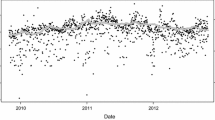Abstract
Tacit collusion between National Power and PowerGen, the dominant generators in England and Wales for most of the 1990s, was widely speculated but was not definitively proven. In the event of a legal determination, the best available evidence is a test of suspicious patterns of bidding behavior. The methodology has two stages: the first is to show that the suspects behave “differently” from the rest, which are assumed competitive; the second stage is to ask whether or not strategies of suspects affect one another. Results: the impact of suspects on the aggregate bid function can not be explained away by costs and common market events, and a seemingly unrelated regression (SUR) on strategies of the suspects reveals bid inter-dependence and co-ordination on demand trends. A quarter of the dynamic indicators support an inference of tacit collusion. The existence of multiple equilibria in supergames, however, prevents a conclusive statement.
Similar content being viewed by others
References
Baldick, R., Grant, R. & Kahn, E. (2000). “Linear Supply Function Equilibrium: Generalizations, Application, and Limitations.”PWP-078, University of California Energy Institute.
Borenstein, S. (1999). “Understanding Competitive Pricing and Market Power in WholesaleElectricity Markets.” PWP-067, University of California Energy Institute.
Cramton, P. & Schwartz, J. A. (2000). “Collusive Bidding: Lessonsfrom the FCC Spectrum Auctions.” Journal of RegulatoryEconomics. 17, 229–252.
von der Fehr, N.-H. M. & Harbord, D. (1993).“Spot Market Competition in the UK Electricity Industry.” Economic Journal. 103, 531–546.
Green, R. J. (1996). “IncreasingCompetition in the British Electricity Spot Market.” Journal of Industrial Economics. XLIV, 205–216.
Green, E. J. & Porter, R. H.(1984). “Noncooperative Collusion under Imperfect Price Competition.” Econometrica. 52, 87–100.
Green, R. J. & Newbery, D.M. (1992). “Competition in the British Electricity Spot Market.” Journal of Political Economy. 100, 929–953.
Haltiwanger, J. & Harrington, J. E., Jr. (1991). “The Impact of Cyclical Demand Movements on Collusive Behavior.” RAND Journal of Economics. 22, 89–106.
Macatangay, R. E. (2000). “Strategic Behavior of Gensets across the Transmission Grid of England and Wales.” Mimeo, Universityof California Energy Institute.
Porter, R. H. & Zona, J. D. (1993). “Detection of Bid Rigging in Procurement Auctions.” Journal of PoliticalEconomy. 101, 518–538.
Porter, R. H. & Zona, J. D. (1997). “Ohio School Milk Markets: An Analysis of Bidding.” WorkingPaper 6037, Cambridge, MA: National Bureau of Economic Research.
Rotemberg, J. J. & Saloner, G. (1986). “A Supergame-Theoretic Model of Price Wars During Booms.” American Economic Review. 76, 390–407.
Staiger, R. W. & Wolak, F. A. (1992).“Collusive Pricing with Capacity Constraints in the Presence of Demand Uncertainty.” RAND Journal of Economics. 23, 203–220.
Tirole, J. (1988). The Theoryof Industrial Organization, Cambridge, MA: MIT Press.
Wolak, F. A. & Patrick, R. H. (1997). “TheImpact of Rules and Market Structure on the Price Determination Process in the England and Wales Electricity Market.” Mimeo, Stanford University Department of Economics.
Wolfram, C. D. (1998). “Strategic Bidding in a Multiunit Auction: An Empirical Analysis of Bids to Supply Electricityin England and Wales.” RAND Journal of Economics. 29, 703–725.
Wolfram, C. D. (1999). “Measuring Duopoly Power in theBritish Electricity Spot Market.” American Economic Review. 89, 805–826.
Author information
Authors and Affiliations
Rights and permissions
About this article
Cite this article
Macatangay, R.E.A. Tacit Collusion in the Frequently Repeated Multi-Unit Uniform Price Auction for Wholesale Electricity in England and Wales. European Journal of Law and Economics 13, 257–273 (2002). https://doi.org/10.1023/A:1014730803412
Issue Date:
DOI: https://doi.org/10.1023/A:1014730803412




